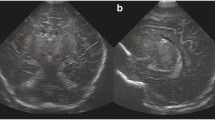Summary
A “bright thalamus” is not uncommonly observed in cranial sonograms of asphyxiated neonates, but not those of older infants. Three infants, aged 9–14 months, developed acute onset of seizures and disturbance of consciousness after a minor prodromal illness. Bilateral thalamic infarcts were demonstrated by ultrasonography and CT. One patient expired from causes not directly related to the infarcts; the other two survived with severe neurological sequelae.
Similar content being viewed by others
References
Leech RW, Alvord EC Jr (1977) Anoxic-ischemic encephalopathy in the human neonatal period. Arch Neurol 34:109–113
Kotagal S, Toce S, Kotagal P, Archer C (1983) Symmetric bithalamic and striatal hemorrhage following perinatal hypoxia in a term infant. J Comput Assist Tomogr 7:353–355
Trounce JQ, Dodd KL, Fawer CL, Fiedler AR, Punt J, Levene HI (1985) Primary thalamic haemorrhage in the newborn. Lancet I:190–192
Primhak RA, Smith MF, Hill AE, Morgan MEI (1985) Primary thalamic haemorrhage in first week of life. Lancet I:635
Donn SM (1985) Possible mechanisms of primary thalami haemorrhage in the newborn. Lancet I:823
Weissman BM, Foster D, Baley JE (1987) Primary thalamic hemorrhage in a preterm infant. Pediatr Neurol 3:121–122
Adams C, Hochhauser L, Logan WJ (1988) Primary thalamic and caudate hemorrhage in term neonates presenting with seizures. Pediatr Neurol 4:175–177
Volt T, Lemburg P (1987) Damage of thalamus and basal ganglia in asphyxiated full-term neonates. Neuropediatrics 18:176–181
Colamaria V, Curatolo P, Cusmai R, Bernardina BD (1988) Symmetrical bithalamic hyperdensities in asphyxiated full-term newborns an early indicator of status marmoratus. Brain Dev 10:57–59
Babcock DS, Ball WS Jr (1983) Postasphyxial encephalopathy in full-term infants: ultrasound diagnosis. Radiology 148:417–423
Kreusser KL, Schmidt RE, Shackelford GD, Volpe JJ (1984) Value of ultrasound for identification of acute hemorrhagic necrosis of thalamus and basal ganglia in an asphyxiated term infant. Ann Neurol 16:361–363
Shen EY (1984) The “bright thalamus”. Arch. Dis Child 59:695
Hertzberg BS, Pasto ME, Needleman L, Kurtz AB, Rifkin MD (1987) Postasphyxial encephalopathy in term infants: sonographic demonstration of increased echogenicity of the thalamus and basal ganglia. J Ultrasound Med 6:197–202
Shen EY, Huang CC, Chyou SC, Hung HY, Hsu CH, Huang FY (1986) Sonographic finding of the bright thalamus. Arch Dis Child 61:1096–1099
Shen EY, Lin JCT, Shih CC (1988) Pathological echogenicity of the thalamus in newborn and young infants. J Formosan Med Assoc 87:891–897
Bogousslavsky J, Regli F, Uske A (1988) Thalamic infarcts: clinical syndromes, etiology, and prognosis. Neurology 38:837–848
Castaigne P, Lhermitte F, Buge A, Escourolle R, Hauw JJ, Lyon-Coen O (1981) Paramedian thalamic and midbrain infarct: clinical and neuropathological study. Ann Neurol 10:127–148
Bewermeyer H, Dreesbach HA, Rackl A, Neveling M, Heiss W-D (1985) Presentation of bilateral thalamic infarction on CT, MRI and PET. Neuroradiology 27:414–419
Gerber O, Gudesblatt M (1986) Bilateral paramedian thalamic infarctions: a CT study. Neuroradiology 28:128–131
Gentilini M, De Renzi E, Crisi G (1987) Bilateral paramedian thalamic artery infarcts: report of eight cases. J Neurol Neurosurg Psychiatry 50:900–909
Eick JJ, Miller KD, Bell KA, Tutton RH (1981) Computed tomography of deep cerebral venous thrombosis in children. Radiology 140:399–402
Kim KS, Walczak TS (1986) Computed tomography of deep cerebral venous thrombosis. J Comput Assist Tomogr 10:386–390
Gupta KL, Kapila A, Duvall ER (1987) Computed tomographic evaluation of deep cerebral venous thrombosis. Ala J Med Sci 24: 41–45
Ashforth RA, Melanson D, Ethier R (1989) MR of deep cerebral venous thrombosis. Can J Neurol Sci 16:417–421
Vomberg PP, Breederveld C (1987) Cerebral thromboembolism due to antithrombin III deficiency in two children. Neuropediatrics 18:42–44
Vannucci RC, Voorhies TM (1984) Perinatal cerebral hypoxia-ischemia: pathogenesis and neuropathology. In: Sarnat HB (ed) Topics in neonatal neurology. Grune and Stratton, Orlando, pp 27–59
Rorke LB (1982) Pathology of perinatal brain injury. Raven Press, New York
Myers RE (1975) Four patterns of perinatal brain damage and their conditions of occurrence in primates. Adv Neurol 10:223–234
Author information
Authors and Affiliations
Rights and permissions
About this article
Cite this article
Wang, H.S., Huang, S.C. Infantile panthalamic infarct with a striking sonographic finding: the “bright thalamus”. Neuroradiology 35, 92–96 (1993). https://doi.org/10.1007/BF00593961
Received:
Issue Date:
DOI: https://doi.org/10.1007/BF00593961




